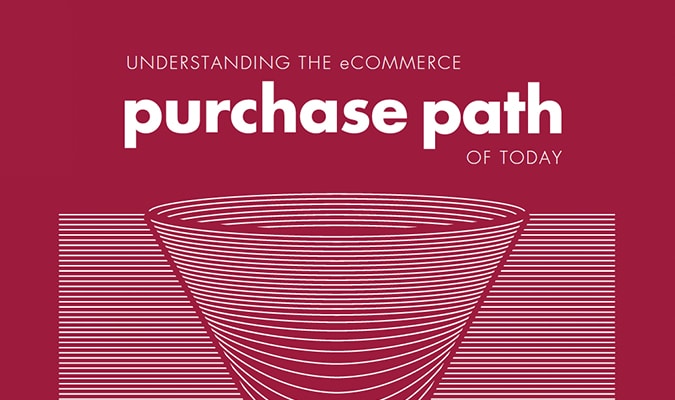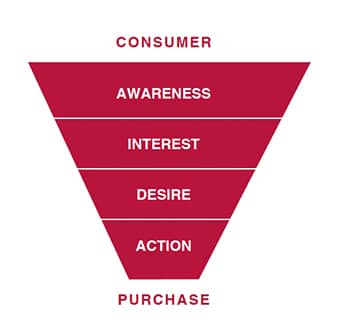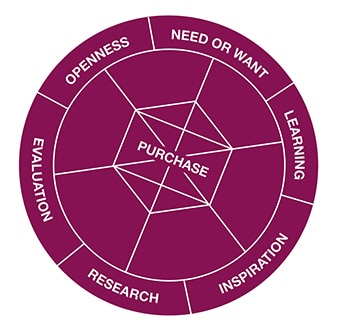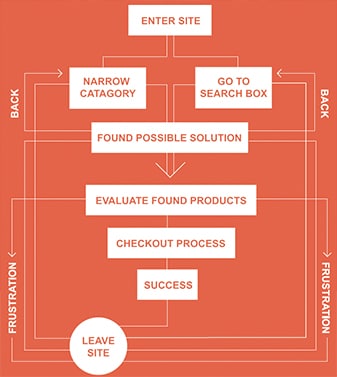Understanding the eCommerce Purchase Path of Today

WHY IT IS CHANGING AND HOW YOU CAN ADAPT YOUR MARKETING APPROACH
THE AIDA PURCHASE PATH MODEL
AWARENESS
A consumer knows something about your product or service. Typically, paid media or earned media are used to tell the brand story. At this stage, the consumer may not have a need for your product/service. High level, engaging content is key for this area.
Example of Awareness: I’ve heard of the brand Coke. (TM)
INTEREST
At this stage, the consumer has a need. The consumer is actively seeking out a product/service to fulfill a specific need, regardless of brand. Content surrounding your product/service’s features are crucial so the consumer understands exactly what your company is offering.
Example of Interest: I am thirsty.
DESIRE
Now, both awareness and interest come together. The consumer knows about your brand and has a specific need for your brand. Now, it’s time to show how your brand is the perfect fit. Content surrounding the benefits of your product/service should be used at this stage.
Example of Desire: Coke (TM) can help you quench your thirst.
ACTION
This is the buy stage. The consumer has decided it is your product/service that fulfills their need and they take the step to buy. Price positioning at this stage may be the final content piece needed to push a consumer to buy.
Example of Action: Consumer buys a Coke (TM) to quench their thirst.
As they edge closer and closer, he or she is deselecting options along the way, and they have the potential of deselecting your brand. This is called “fallout.” Fallout results in fewer and fewer potential customers making it all the way through the buying process. Therefore, the purchase path is typically depicted as a funnel.
The purchase path funnel is critical for eCommerce sales. Understanding fallout, the ability to remarket to lost customers, and ultimately converting those customers is a way for companies to make up lost revenue.
THE LOOP PURCHASE PATH MODEL
OPENNESS
In this stage, the potential customer may not know about your brand but is open to receiving your message.
LEARNING & EDUCATION
Learning and education is a new phase, and is amplified in the eCommerce space. Studies have shown consumers need on average ten different pieces of information to make a decision. Even seemingly simple purchases have taken on a whole new aspect when looking at how much information users need to make a decision.
SEEKING IDEAS & INSPIRATION
Again, similar to the Desire phase in the AIDA model, a consumer is looking for those brands that not only meet but exceed their needs.
REALIZE WANT OR NEED
This is very similar to the Interest phase in the AIDA model. Consumers understand they have a need and are looking for ways to fulfill it.
RESEARCH & VETTING
Another new phase, after all of the upfront research has been done, is that consumers are looking for social proof that their decision was appropriate. Consumers in this stage will post pictures for feedback, read ratings and reviews, and search for posts on the product/service to help validate their decision.
POST PURCHASE EVALUATION & EXPANSION
In the purchase loop model, the buy is not the end step. Consumers go on to evaluate, comment, post and spread the word about their purchase. Even in this stage, brands have the opportunity to speak to their customers, reaffirm the purchase of the consumer and prepare them for the next purchase. 
The study identified not four areas as the AIDA model suggests, but six distinct behaviors customers move through toward purchase.
The purchase path is a loop in that one continually moves through the process rather than from point A to B.
IMPLICATIONS
The mobile purchase funnel adds additional complexity. mCommerce sales increased 82% in 2012 to be just under $25 billion and are expected to rise to $40 billion in 2013. As more purchases occur on smartphones and tablets, we will see more disruption to the traditional purchase funnel. Disruption, by companies such as Foursquare, will look to affect a purchase decision at the point of purchase. For example, if I am walking up to enter one restaurant and the restaurant next door offers me a special or no-wait seating, then I may be inclined to change my purchase on the spot.
It is a brave new world when it comes to eCommerce purchases and consumer behavior will continue adapting to follow these technologies.
WHAT IS A CONVERSION PATH
Conversion path and purchase path are sometimes intermingled in parlance. However, they are two clearly distinct activities. A purchase path, in the traditional aspect, has four distinct areas a customer moves through to purchase a product. But a conversion path can have one to many ways to purchase. A conversion path highlights all of the ways one enters a website and all of the web pages a user visits before buying. The fewer pages one visits before buying, the better. The more pages a user visits increases the likelihood of time and distraction becoming delimiting factors in completing a sale.
HOW A CONVERSION PATH TRANSLATES TO A PURCHASE PATH
A website homepage is typically the start of a conversion path and can be compared to the Awareness phase in the purchase path. About Us, Blog and News pages on the site are associated with the Interest phase as they help define the company and what they sell. Product category pages help align one’s needs with the offerings of the company, reaffirming how the product or service will benefit the potential customer (thus, representing the Desire phase). Finally, a Product page with a “buy” button reflects the Action phase.
Not all sites have this exact conversion path. Certainly not all companies sell products. There are plenty of service offerings available. Regardless of the products or services being offered, every site should have a conversion opportunity. These conversions can be email sign-ups, social media follows, video views, RSS sign-ups or white paper downloads. It is important to have a call-to-action to provide ROI and justify the amount of time and resources you are putting into your eCommerce marketing efforts.
COUNTERACTING CART ABANDONMENT
Purchase path funnel assumes one makes it through the entire process, from first coming to the site to purchase. That is not always the case. Most of the time, a user will fall out of the process and not complete the purchase–otherwise known as shopping cart abandonment. Studies have shown an abandonment rate, the percent of those who leave the purchase path, between 55% and 80%. Which means only 20% to 45% of those people you have driven to your site via marketing activities actually convert. eMarketer found consumers have a number of reasons for abandoning the cart, including not being ready to purchase and trying to ascertain the impact of shipping costs.
A way to gain sales very easily is by converting those who have visited the site. A ten percent reduction in shopping cart abandonment rate would be a significant addition to your bottom line.
MONITORING “ADD-TO-CART” BEHAVIOR
Another issue within the purchase path is the “add-to-cart” behavior. Many users will add items to a cart for later purchase. They may be on their phone and prefer to buy on their desktop. They may not have time to complete the purchase now but will come back to it. eCommerce sites should look at using incentives or reminders to encourage users to continue their purchase. In addition, review how a user moves through the cart on a mobile device. Is it mobile friendly? Removing any barriers and making the mobile experience as easy as possible will help decrease abandonment rates.
FIVE WAYS TO DECREASE CART ABANDONMENT
1) Provide Value to the Purchase Path:
Have strategies to address fallout along each step of the funnel. Email, resource guides, promotions and so forth are all ways a brand can provide value and drive users back to the site.
2) Eliminate Errors on the Website:
A broken path to purchase is the easiest way for users to leave the purchase path. Test and revisit the path on a frequent basis to ensure site errors do not stop users from purchasing.
3) Conversion Optimization:
Conversion optimization is a process of continually improving the path to purchase. As the way users shop online changes, a continual process of improving the purchase path will greatly increase the chance of conversion.
4) Offer Assistance:
Online chats, emails and phone numbers are ways to help users if they have questions during purchase. It deters users from becoming frustrated in the purchase process if they can have their questions answered directly.
5) Have Inventory Available:
Monitor your inventory carefully and make sure you have inventory available, in all sizes and colors, on your site. Driving a user to a website with little to no inventory is a sure way to increase abandonment rates.